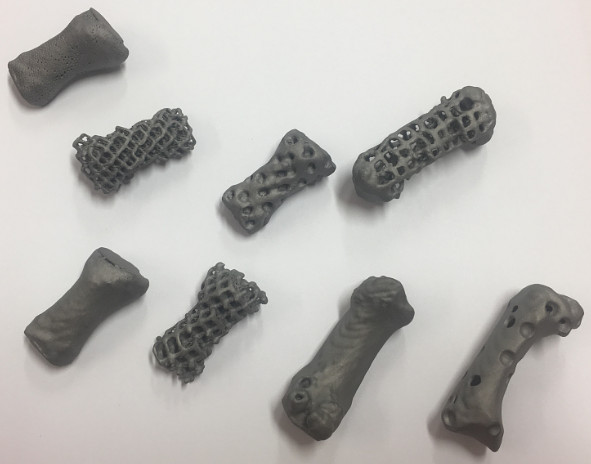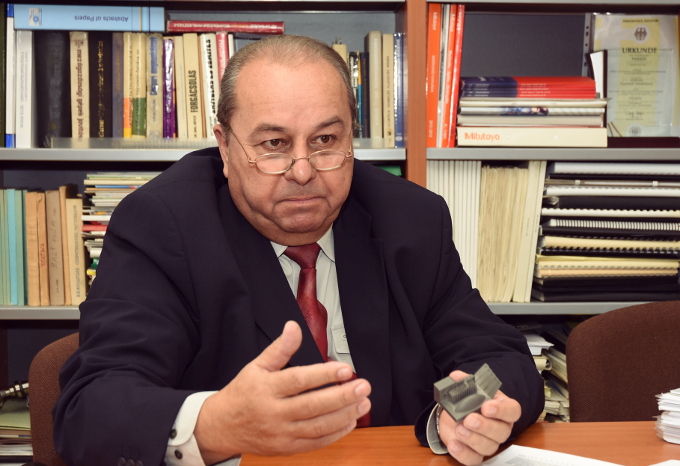News feed
Large-scale project launched at BME to develop new generation medical implants
2018. 01. 02.BME received funding to develop the manufacturing processes of personalised medical devices and implants that improve patients’ quality of life.
The research into the manufacturing potential and complete manufacturing processes of high-quality bio-medical devices which are competitive, as well as cost- and resource-effective in the long term was summed up by János Takács, professor of the Department of Automotive Technologies at the Faculty of Transportation Engineering and Vehicle Engineering and the university coordinator of the scientific project as follows: “The recently launched research, which is the result of an unprecedented cooperation between industry and the university, is aimed at creating the conditions for a high quality of life for patients”.

BME is the only higher education institution in the consortium, collaborating in the 3-year project with VARINEX Zrt as its industry partner. The company manufactures virtual and real prototypes and provides computer-aided design in engineering and civil design. The project is financed by the National Research, Development and Innovation Fund: most of the over HUF 745 million financing, HUF 599 million was awarded to BME to fund its scientific work in the subject. (Editor note: Full title of the application: “Developing new generation additive layer manufacturing technologies for personalised bio-medical implants and devices”.) It is aimed at data collection and processing, modelling using CT-images, virtual manufacturing, “3D printing” of designs and validating control samples. The partners also plan to develop an R&D and a manufacturing technology sample system, as well as a smart plant, ensuring the system-level research of the manufacturing potential of personalised implants, which are characterised by improved biocompatibility with the human body and enable patients to heal faster.
| The project is made unique by the involvement of several BME departments and faculties, including the Department of Automotive Technologies and the Department of Vehicle Elements and Vehicle-Structure Analysis of the Faculty of Transportation Engineering and Vehicle Engineering, the Department of Polymer Engineering, the Department of Materials Science and Engineering, the Cooperation Research Centre for Biomechanics, the Department of Mechatronics, Optics and Mechanical Engineering Informatics, the Department of Machine and Product Design of the Faculty of Mechanical Engineering, as well as the Informatics Laboratory of the Dean’s Office at the Faculty of Transportation Engineering and Vehicle Engineering. |
János Takács described the concerns related to previously used medical implants for humans, which have become the incentive for this research: “most implants are expected to function safely for about 15 years, after which they may have to be replaced, which means another operation and rehabilitation process for the patients. Implants are usually secured with bone cement (medical-grade resin) and their removal may cause damage to human tissue. Another problem is that doctors can only choose from a specific range of implant sizes, which do not consider the specific anatomy of individual patients, so they can feel uncomfortable when implanted”. BME’s researchers tackle these problems by developing a new manufacturing technology and are currently working on designing porous implants with a grid-like internal structure and a membranous outer surface, which can better mimic the rigidity, flexibility, density, force- and load-bearing capacity of human bones. These implants are produced with 3D printing by building layers from plastic and metal powder.
Test specimens are produced by laser sintering from metal powder (titanium-aluminium-vanadium). This process enables the formation of extremely narrow gaps and tiny pores. Using a 20-30 micrometre powder layer, the laser beam builds the test specimen by fusing the powder particles along the contour of the specimen, then scans the cross-sections to build the interior structure. The laser sintering device then repeats the procedure and creates the subsequent layers until the object is ready, that is the prototype reaches its final form within a relatively short time.
Apart from metal powder, the researchers of the Department of Polymer Engineering also experiment with the use of polymers as a base material. The Faculty of Mechanical Engineering has the equipment necessary for making other implants from polymers (such as cranial bone implants or bandages used instead of plaster to secure fractures) and surgical tools (such as surgical drills).

“With our innovations we try to keep up with the ever-changing demands of the industry and the individual users. During our physician-engineer consultations we maintain close contact with the ‘end user’, that is the physician performing the implant surgery and the patient in the hope of developing the best possible solution”, explained the coordinator from BME. He added that they are looking for partners who are able to provide electronically available diagnostic digital images and have the required database. Patient data will then be used by the experts of the consortium, representing the Cooperation Research Centre for Biomechanics and the Department of Mechatronics, Optics and Mechanical Engineering Informatics of the Faculty of Mechanical Engineering, as well as the Informatics Laboratory of the Dean’s Office at the Faculty of Transportation Engineering and Vehicle Engineering as the basis for the design of the 3D printed models.
The university’s researcher welcomed the funding for the project. “After Hungary’s accession to the European Union most of the EU funding went to the disadvantaged convergence regions, while for many years the institutions in central Hungary had very limited options for funding or equipment purchases. This programme is implemented from domestic resources (National Research, Development and Innovation Office) through the tender issued for the Central Hungary Region. This project funding is a significant step forward for the faculties, as well as Budapest University of Technology and Economics as a whole”, said János Takács when evaluating the results. The project enables the institution’s experts to buy a 3D laser beam direct sintering device for the Department of Automotive Technologies, which will be unique in Hungary, suitable for research purposes and can be used with varying parameters.
“The similar devices in other higher education institutions cannot be adjusted to varying parameters, therefore they are only suitable for technologies using specific criteria. They cannot be used to experiment with different materials and their combinations either, while the new device, an almost HUF 100 million ‘printer’ offers much wider options for use: it can be freely parameterised, can produce different modules simultaneously and the high degree of automation allows for the creation of tailor-made test specimens”, János Takács said when explaining the details.
Researchers in the scientific project will use another device to analyse the characteristics of the prototypes: the so-called high-speed spectrometer for material component analysis can be used to monitor the oxygen and nitrogen content of the implants and their environments, as well as their hydrogen content, which plays a crucial role in brittle fractures. The new equipment is able to measure the carbon content (with the required accuracy), which is not possible with other high-speed spectroscopy. Apart from prototypes, they will also make test specimens for mechanical tests, so the experts of the Department of Materials Science and Engineering, the Department of Polymer Engineering, the Cooperation Research Centre for Biomechanics and the Department of Automotive Technologies will not only analyse material components, but physical characteristics too.

A new electron microscope will be used for fine structure spectroscopy at the Department of Materials Science and Engineering. The researchers of the Department of Machine and Product Design, the Department of Vehicle Elements and Vehicle-Structure Analysis and the Department of Automotive Technologies will develop their own macrostructure-building process with which they can produce a model and use the finite element method to see whether it can function under normal and extreme loading conditions.
János Takács brought a practical example to demonstrate the experiments. The firsts tests will analyse the characteristics of a metacarpal implant. “The load on this model is very similar to that of hip implants, so the findings can provide a basis for developing larger implants.” The researchers’ goal is to develop implants that last longer than the current ones and enable patients to lead a better life without the need for reoperation. The professor hopes that the latest innovative findings will be integrated into the university’s programmes within a short amount of time. Students are already involved in research activities. As a result, they have produced several successful undergraduate scientific dissertations and publications on the potential for producing new generation implants.
TZS - GI
Photo: Ildikó Takács
